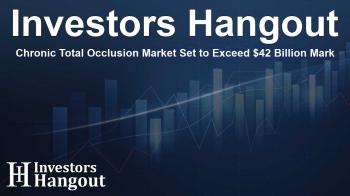Chronic Total Occlusion Market Set to Exceed $42 Billion Mark

Chronic Total Occlusion Market Overview
The chronic total occlusion (CTO) market is witnessing substantial growth due to the increasing rates of cardiovascular diseases globally, coupled with advancements in medical technologies. The demand for CTO devices is driven largely by the rising incidences of obstructive heart conditions and a corresponding rise in procedures aimed at correcting these issues.
Key Drivers of Market Growth
Increasing Prevalence of Cardiovascular Diseases
The prevalence of cardiovascular diseases (CVDs) is escalating, driving the demand for chronic total occlusion procedures. Patients suffering from CVD are more likely to require advanced treatments, which include percutaneous coronary intervention (PCI) to address CTOs. This procedure has gained traction particularly among aging populations, where the risk of heart-related ailments is significantly higher.
According to global health reports, millions suffer from strokes annually, with a significant portion being linked to underlying heart conditions. Projections suggest that a staggering number of people will have some form of CVD in the coming years, emphasizing the urgent need for effective treatment solutions.
Technological Advancements Fueling Treatment Options
Recent technological advancements are pivotal in enhancing the management of CTOs. New devices and methods are enabling medical professionals to perform procedures that were once considered too risky or complex. These advancements include the development of innovative guidewires and catheters designed specifically for CTO procedures, improving patient outcomes and reducing recovery times.
Market Trends and Key Players
Strategic Initiatives by Prominent Companies
Leading players in the CTO market are actively engaging in strategic initiatives to bolster their market position. This includes product approvals, partnerships, and innovations aimed at meeting the rising demand for these medical devices. Noteworthy initiatives include:
- The recent approval of advanced guidewire systems designed for better navigation in vascular interventions.
- The introduction of novel microcatheters that facilitate smoother procedures during PCI, enhancing guidewire support.
- Acquisition of new microcatheter technologies that aim to simplify complex interventions.
- Expanding product lines with FDA approvals for various specialty catheters aimed at chronic total occlusion treatments.
Geographical Insights and Market Segmentation
In terms of geographic performance, the Asia-Pacific region is projected to witness the highest growth, becoming a focal point for advances in healthcare investments and patient care initiatives. This growth is expected to outpace other regions, including North America and Europe.
Market segmentation shows clear distinctions based on the equipment used; guidewires currently hold the largest share, attributed to their critical role in CTO procedures. Meanwhile, hospitals remain the primary end user of these devices, employing advanced techniques and equipment to treat patients effectively.
Future Outlook for the CTO Market
The outlook for the chronic total occlusion market is markedly positive, with a projected value exceeding $42.21 billion by 2031. This growth trajectory is underpinned by factors such as the aging population, increasing lifestyle diseases, and rising healthcare expenditure. Additionally, the trend towards minimally invasive procedures continues to encourage investment in the CTO market.
Healthcare providers are now leaning more towards catheter-based interventions due to the lower risk involved compared to traditional surgical methods. This shift is driving ongoing innovation in the development of new devices to enhance treatment efficacy and safety.
Conclusion
To summarize, the chronic total occlusion market is on an upward path, significantly supported by technological advancements and an increased prevalence of cardiovascular diseases. As stakeholders aim to navigate this evolving landscape, insights gleaned from market reports will enable them to tap into new opportunities, fostering advancements that benefit patient care and outcomes.
Frequently Asked Questions
What is the expected growth of the chronic total occlusion market?
The chronic total occlusion market is projected to reach over $42 billion by 2031.
Which regions are leading in the CTO market?
The Asia-Pacific region is expected to exhibit the highest growth rates in the CTO market.
What factors contribute to the growth of the CTO market?
Growth factors include technological advancements, increasing prevalence of cardiovascular diseases, and rising demand for minimally invasive procedures.
Who are the key players in the CTO devices market?
Major players include Medtronic, Boston Scientific, Terumo, Abbott, and Philips, among others.
How are companies innovating in the CTO sector?
Companies are focusing on product innovation, strategic mergers, approvals, and enhancements in device technology to improve patient outcomes.
About The Author
Contact Dylan Bailey privately here. Or send an email with ATTN: Dylan Bailey as the subject to contact@investorshangout.com.
About Investors Hangout
Investors Hangout is a leading online stock forum for financial discussion and learning, offering a wide range of free tools and resources. It draws in traders of all levels, who exchange market knowledge, investigate trading tactics, and keep an eye on industry developments in real time. Featuring financial articles, stock message boards, quotes, charts, company profiles, and live news updates. Through cooperative learning and a wealth of informational resources, it helps users from novices creating their first portfolios to experts honing their techniques. Join Investors Hangout today: https://investorshangout.com/
The content of this article is based on factual, publicly available information and does not represent legal, financial, or investment advice. Investors Hangout does not offer financial advice, and the author is not a licensed financial advisor. Consult a qualified advisor before making any financial or investment decisions based on this article. This article should not be considered advice to purchase, sell, or hold any securities or other investments. If any of the material provided here is inaccurate, please contact us for corrections.

